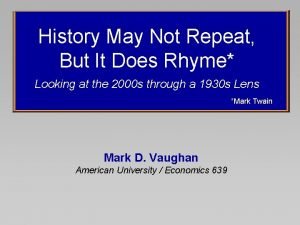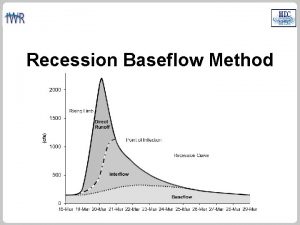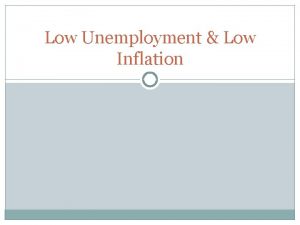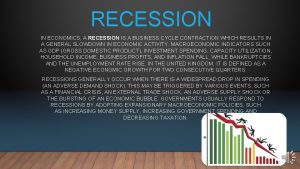Spain RECESSION UNEMPLOYMENT Evaluating the impact of Recession
























- Slides: 24

Spain RECESSION & UNEMPLOYMENT Evaluating the impact of Recession and Government Responses World Bank Institute. 2011 María Mercedes Introini

SUMMARY I. Introduction. II. Spain within EU. III. Government recession measures IV. Rate of Unemployment: 20, 33% Why? V. Forecast VI. Conclusions.

INTRODUCTION Spain slipped into recession at the end of 2008. In the first quarter of 2010, GDP has increased at 0. 1% and this is the first rise for this indicator, after seven consecutive quarters of contraction. Most of the fourth-quarter contraction is attributable to a 2. 4 % fall in domestic investment and consumption, the Bank of Spain conclude that the drop in spending by households had an even bigger negative impact than the end of Spain's extended housing and construction boom. Basically the roots of the Spanish "problem" are undoubtedly many and complex, but there is one underlying ingredient in the present dynamic which more or less governs everything else: the dependence on external financing due to the ongoing http: //www. surinenglish. com/20090129/ news/spain/government-confirms-thatcurrent account deficit, spain-200901290941. html http: //spaineconomy. blogspot. com/2008 /11/spanish-crisis-in-nutshell. html

INTRODUCTION Since the onset of the economic crisis, Spain, fourth largest economy of the euro zone, has seen its official unemployment rate double to almost 20% of the workforce, going from 1. 76 million unemployed in the second quarter 2007 to 4. 6 million in the first quarter of 2010. However, Spain can be considered a successful model of labor integration, which has incorporated a large number of immigrants. In 10 years, these came to account for 10 % of the total population. Temporary jobs rapidly grew according to this demand, but the recession destroyed most of them, leaving thousands of people without a job, what led to a big increase in the number of people getting unemployment benefits, and inflating public spending dramatically.

SPAIN GDP GROWTH 1998 -2010

SPAIN UNEMPLOYMENT 1998 -2010

Spain within EU

Why has unemployment risen so much more in Spain than in most of the other European countries? Juan Dolado from University Carlos III Spain answered this question in a very interesting interview: “Because of the great segmentation in the labor market. The old permanent/ temporary contracts divide; this is what I've christened as a ‘bulimic’ labor market. So it's a labor market, which creates a lot of jobs during expansions and destroys a lot of jobs during the recessions. So the volatility, for instance, of the Spanish market is about twice the US labor market, which is amazing given that two thirds of the population have been enjoying extremely rigid contracts with very difficult to dismiss and also difficulties of hiring. And still you have this one third of the population, which is just like workers in Hong Kong in the spot market, where they get hired on Mondays, fired on Tuesdays, rehired on Thursdays, and so on and so forth. The basic difference between Spain and other countries in my view has to do with this great divide. So basically what happens is that the firing clause for permanent contracts and the timing of the legal disputes for permanent contracts is very, very expensive as opposed to temporary contracts. So the conversion typically is natural, that temporary contracts are perfect contracts for youngsters as sort of stepping-stone. But this stepping-stone never occurs because employers refuse to promote these workers in the fear of having to pay this high dismissal cost…” Source: http: //www. voxeu. org/index. php? q=node /5550

IMF analysis Euro zone The World Economic Outlook (April 2010), identify some key points: Large deficits. Debt sustainability (Greece, Ireland, Portugal, Spain). Fiscal challenge in most European countries need to be addressed. http: //www. imf. org/external/pubs/ft/weo/ 2010/01/pdf/text. pdf 7 pag 53 Monetary policy remain highly accomodative in most cases. Recovery process are still sluggish. Inflation pressures remain subdued. Conclusion: Europe´s growth perspective is expected to be modest Advanced Europe´s countries GDP is projected to grow at 1 ¾% and in real activity is expected to be 3 1/2% in 2011

GDP growth and vulnerability Spain & others EU countries COUNTRIES GDP 2010 VULNERABILITY SPAIN -0, 7% HIGH FRANCE 1, 3% MEDIUM GERMANY 1, 2% MEDIUM ITALY 0, 5% MEDIUM UK 0, 4% MEDIUM BELGIUM 1, 1% MEDIUM GREECE 2, 0% MEDIUM NETHERLANDS 1, 8% MEDIUM CZECH REPUBLIC 2, 0% MEDIUM POLAND 2, 9% MEDIUM http: //www. gfmag. com/gdp-data-country -reports/286 -the-czech-republic-gdpcountry-report. html

Government recession measures Pros Cons u Fiscal austerity u Inflation and unemployment: u Reductions on public spending. 1. -Debt u Reduction of budget deficit from 11, 2% GDP in 2009 to 3% in 2013. 3. -Financial institutions have stopped doing business in the country. u Reforms of labor market. 2. -Rising mortgage interest 4. -International credit crisis 5. -Decline construction sector. u Reduction on technology innovation and finance to

DIAGNOSIS Ø Spain duplicates the rates of unemployment in comparison with others countries before a similar recession. Ø Wage inflexibility and dual labor market. Ø Spanish labor market suffers seriuous institutional and structural problems. Ø Cost gap of dismissal between indefinite workers and temporay ones. Ø Insider –outsider market Ø Current system collective bargaining

DIAGNOSIS Ø High dismissal costs for workers on indefinite contract have made firms reluctant to make new permanent hires. Ø In the current crisis, temporary jobs are the first to be eliminated, leaving in particular young workers, women and immigrants with much higher unemployment rates. http: //economy. blogs. ie. edu/archives/20 08/12/imf_calls_for_l. php Negative GDP growth Public sector debt High deficit Cause of this vicious circle, Standard & Poor´s lower its rating on Spain´s sovereign debt from “stable” to “negative”.

Property bubble Ø Since 1997, almost 1/5 of Spanish GDP growth have been generated by the construction sector. Ø 70% of the two million jobs which were lost in Spain since the start of the economic downturn were directly or indirectly related to the construction sector. Ø In 2010 have reached a “historical fall” of -16%. Ø Forecast for 2011: -13, 6% http: //www. dawn. com/2011/02/21/worldeconomies-13. html http: //www. interempresas. net/Construcc ion/Articulos/46165 -recesion-seguiragolpeando-a-construccion-en-2011 -con-

Spain and USA Added value of construction within the total GDP http: //www. eleconomista. es/economia/n oticias/218869/05/07/La-viviendaamenaza-la-economia-espanola-puede-

20, 33% Why? 1) Special measures of unemployment. : SPEE. Public service registration employment service. Measures uemployment taking into accounts the number of people registering as unemployed in their offices. LFSurvey (elaborated by the Statistics national Institute) that consists of a survey used evenly throughout the EU, measures the labor force, the empoloyed and unemployed, through telephone interviews. There are visible contradictions between the two systems: P. e in the second quarter of 2010: SPEE registered: 3, 9 million people unemployed LFS registered : 4, 64 million people unemployed

20, 33% Why? 2) Wage inflexibility The unemloyment is the result of the falls of the economic activity in the recessive phases of the cycle. When a country duplicates the rates of unemployment of others before a similar recession, since it has happened frequently in Spain, it shows that his labor market suffer serious institutional and structural problems. 3) Dual labor market. The cost gap dismissal between indefinite workers and temporay ones is enormous, since they are very low for the second ones, which are young women of more recent incorporation to the labor market, with high qualification, which one dismisses easily. There exists a labor dual market when a recession comes they dismiss independently of knowledge, qualification, effort or performance. The rotation of the temporary contracts is really high and increase and promote inequality

20, 33% WHY? 4) Permanent and temporary contracts: According to the results of a study made by Prof. Dolado (University Carlos III Madrid, Spain) here are the main reasons of the high rate of unemployment. With the recession, temporary workers declined by 20% (7% for total employment). As a consequence they give rise to a dual and segmented labor market “…a much more lax regulation on the use to temporary contracts and the rigidity of indefinite contracts discourages the investment of the companies in sectors of high added value and, on the contrary, they promote the specialization in sectors of low added value, like the residential construction that has been one of the most affected in the crisis…” http: //www. uc 3 m. es/portal/page/portal/a ctualidad_cientifica/noticias/contratos_p aro

20, 33% WHY? The authors of the work plead for the elimination of the majority of temporary contracts and the implementation of a unique labor contract with an indemnization for dismissal as a way to reduce volatileness and high rate of unemployment. 5) Unreliable data of people that claim benefits and work unoficially. 6) Rigidity market labour. : Lack of part time jobs (12% of total workers. ) with an estimated loss of 1, 5 millons of potential workers The strict current regulation dissuades the permanent contracting of the companies and the mobility of the workers of a contract to other one since they would lose his rights of dismissal on having changed company.

Rigidity labor market Spain & OECD standards ie s) sa la r ks w ee w es or k is D ho s is a ur ld m s is sa iffic ul ls tie pe s nd in g (o n ul ti ic m D is ig id di ff R ra ct on t C http: //books. google. es/books? id=b 6 m. Gf GT 70 FAC&pg=PA 98&dq=OECD+stand ards+labor+spain&hl=es&ei=vclw. TZPx M 8 Kt 8 AOCi. Kmv. CA&sa=X&oi=book_res Spain OECD Sstandards LE V E LS O F RI G I DI T Y 80 60 40 20 0

Rigidity labor market Spain & countries. Spanish labor markets are 180 among the most rigid 160 systems in the 140 world, despite a series of 120 small reforms since the 100 1980 s. USA is the more flexible. http: //www. libertaddigital. com/economia /espana-supera-en-rigidez-laboral-apaises-tercermundistas-como-malawi-oghana-1276349945/ zu el a Ve ne ia Bo liv do r Ec ua n Sp ai U Ecuador and Venezuela are the most rigid. SA 80 9 of 10 of new unemployed 60 40 workers in Europe are 20 spanish. 0

Labor reform The reform aims to : 1. - reduce the duality of the labor market. 2. - increase the internal flexibility of the companies 3. - facilitate the adjustments of permanent workers 4. - help to reduce the excessive resource of use of temporary contracts. 5. -lower dismissal costs 6. -boost hiring of younger and better educated workers, 7. - more flexible collective bargaining agreements to prevent bankruptcies and preserve jobs. 8. -use of agencies deprived of placement and labor intermediation, in collaboration with public services of employment. http: //papers. ssrn. com/sol 3/papers. cfm? abstract_i d=156451

FORECAST Spain Government & IMF 20. 00% 10 F IM FORECAST http: //imarketnews. com/node/17312 http: //gestion. pe/noticia/486535/espana-revisa-bajacrecimiento-economico http: //www. ambito. com/noticia. asp? id=544777 http: //www. imf. org/external/pubs/ft/weo/2010/01/index. htm 20 20 13 en t G ov e rn m en t F ov e IM G G ov e rn m en t 20 11 -10. 00% 20 12 0. 00% rn m Axis Title 10. 00% GDP growth Unemployment

POVERTY AND UNEMPLOYMENT
 The 4 phases of the business cycle
The 4 phases of the business cycle Recession and depression
Recession and depression Three ranges of as curve
Three ranges of as curve Words that rhyme with recession
Words that rhyme with recession Agnosist
Agnosist Boom recession depression recovery
Boom recession depression recovery Brushing technique for gingival recession
Brushing technique for gingival recession Symtoms of bronchitis
Symtoms of bronchitis Loanable funds graph recession
Loanable funds graph recession Stillman cleft definition
Stillman cleft definition Trời xanh đây là của chúng ta thể thơ
Trời xanh đây là của chúng ta thể thơ Số nguyên tố là số gì
Số nguyên tố là số gì Thiếu nhi thế giới liên hoan
Thiếu nhi thế giới liên hoan Tỉ lệ cơ thể trẻ em
Tỉ lệ cơ thể trẻ em Fecboak
Fecboak Các châu lục và đại dương trên thế giới
Các châu lục và đại dương trên thế giới Thế nào là hệ số cao nhất
Thế nào là hệ số cao nhất Sơ đồ cơ thể người
Sơ đồ cơ thể người Tư thế ngồi viết
Tư thế ngồi viết Cái miệng nó xinh thế
Cái miệng nó xinh thế Hát kết hợp bộ gõ cơ thể
Hát kết hợp bộ gõ cơ thể đặc điểm cơ thể của người tối cổ
đặc điểm cơ thể của người tối cổ Mật thư tọa độ 5x5
Mật thư tọa độ 5x5 Tư thế worm breton
Tư thế worm breton Tư thế ngồi viết
Tư thế ngồi viết















































